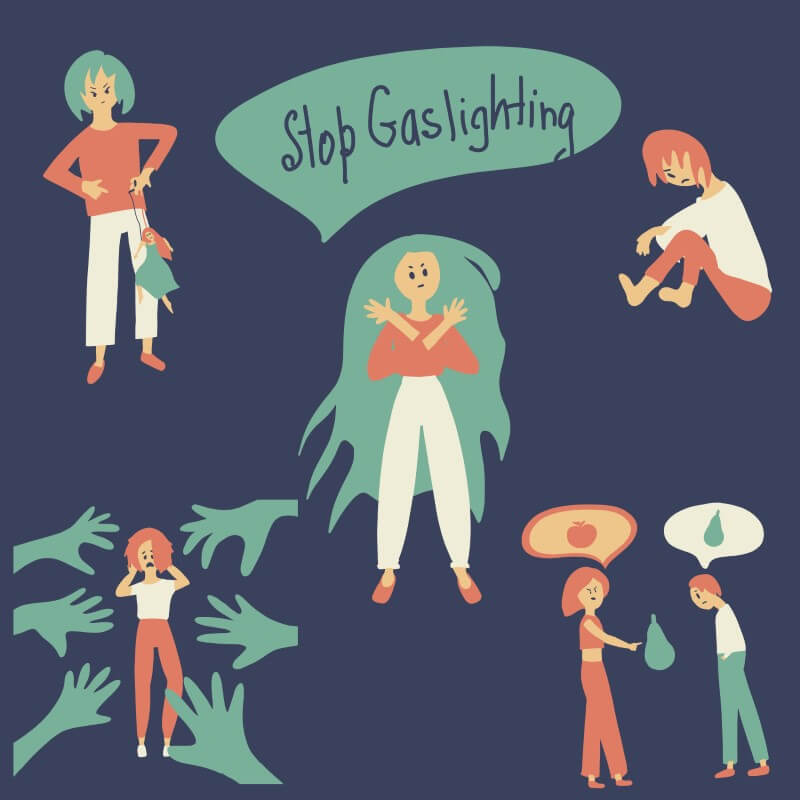If you’re a busy online dater or you’re interested in several forms of serious relationships, you may have heard the term “gaslighting” before, especially in reference to abusive relationships or relationships that involve narcissism.
Gaslighting: What is it?
Gaslighting is a form of psychological manipulation, psychological abuse, and emotional abuse. It can happen in any type of relationship: romantic, friendship, family, or work. Gaslighting is not simply a disagreement or difference in perception of reality. It is a pattern of undermining and questioning another’s reality to the point where they question their own sanity and perception.
Gaslighting techniques and gaslighting behavior looks like:
- Lying
- Minimizing, discounting, or making you question your perception, thoughts, and memories
- Invalidating your feelings or concerns
- Discrediting you to others or aligning people against you
- Deflecting blame or blame-shifting
- Denying they said or did something (rewriting history)
- Denying wrongdoing and avoiding responsibility for choices
- Telling you that you shouldn’t trust others
- Hiding things then pretending they don’t know anything about it
- Degrading statements or false accusations
- Countering and diverting
- Twisting stories in their favor
- Projecting
- Withholding information
- Isolating you from others
- Sporadic positive reinforcement to confuse you
Gaslighting is a way of slowly undermining your perception, self-trust, and self-worth. It leaves you feeling confused, disoriented, and insecure.

Where does the term gaslighting come from?
The term gaslighting comes from a 1938 British play, Gas Light, which became the film Gaslight in 1944. In the film, the husband manipulates his wife and convinces her that she has gone insane.
One of the ways in which the husband manipulates his wife is by slowly dimming the gas lights in their home. When she comments on the dimmed lights, he pretends the lights are the same and convinces her that she is hallucinating. He also makes loud noises in their sealed-off attic, then denies it to make her believe she is hearing noises and voices.
Gaslighting examples
In toxic relationships, gaslighting may look like cheating but making you think you’re crazy for questioning them. It can look like them making you feel too needy or too sensitive, not allowing you to talk during conflict, or denying they said or did something.
At work gaslighting may look like trivializing your perspective or distorting your words. It can look like saying you’re misinterpreting a coworker’s behavior to make you question your perception.
Gaslighting at work can also look like saying they never got your project, article, or presentation when you definitely sent it, moving or removing things on your desk without saying anything, or pretending they’re doing something (like giving you a raise) when they actually aren’t.
In childhood, gaslighting may have looked like unpredictable parenting, your parents trying to look perfect to the outside world, invalidating your thoughts and feelings, or lying to you.
If your family member denied something you knew was true, said they did something terrible or hurtful to you because they love you, or said things like“You’re not hungry, you just ate,” you may have been gaslit.

Here are a few common phrases that indicate gaslighting:
- You’re too sensitive
- It was a joke, you have no sense of humor
- You’re overreacting
- It’s no big deal
- Stop acting crazy/ dramatic
- Why would you think that?
- That’s not true, you’re making that up
- That never happened
- Don’t you remember?
- Others have it worse
- You’re being irrational
- You’re just insecure/jealous
- You’re too emotional
- You’re imagining things
- Stop taking everything so seriously
- I criticize you because I care
- You’re overthinking this
- You should have known…
How gaslighting affects you
Gaslighting is a manipulation tactic that causes you to second-guess yourself and question your memories, perceptions, sanity, and sense of reality. Someone who is gaslighting you will undermine or discount your reality by denying your thoughts, perceptions, memory and feelings. It feels confusing and disorienting.
If you have been gaslighted, it is likely that you have begun to gaslight yourself, questioning and discounting your own reality and your own memory.
The gaslight effect will cause you to doubt your perceptions, memories, thoughts, and feelings. You’ll find yourself second-guessing yourself, over-apologizing, and worrying about being wrong or about others thinking you’re lying. This can lead you to wonder if you’re going crazy or insane or wonder if something’s wrong with you.
You may start to believe you’re too sensitive and begin to minimize your own problems and feelings. You’ll find yourself putting others before you and making excuses for others’ behavior.
If you’ve been gaslit while dating, in a relationship, at work, or in childhood, you may feel confused, anxious, insecure, or inadequate. You may distrust yourself, which leads you to have trouble making decisions. Ultimately, you’ll struggle with confidence and self-esteem until you learn how to trust yourself again.

Why people gaslight
Gaslighting is a technique people use to feel more in control and get what they want. People who gaslight may feel insecure and anxious, leading them to need to feel right and gain control. It can be seen as a survival strategy.
Some people gaslight intentionally to bully and confuse others. However, I’ve found that most gaslighting happens unintentionally.
Many times, people don’t even realize they are gaslighting. It is often an unconscious habit that is learned from parents or other role models. It usually starts slowly and gradually. Most people who gaslight do not realize or believe they are manipulative. They may themselves be out of touch with reality.
Underneath gaslighting behavior is often insecurity, low self-worth, fear, and anxiety. This leads to a belief that having power and control will boost self-esteem and relieve fear and anxiety. If someone is gaslighting you, there is a good chance that they also gaslight themselves.
How to protect yourself from gaslighting
If you have been a victim of gaslighting, you have to get in touch with your own reality and learn to trust yourself again.
The first step to protecting yourself from gaslighting is educating yourself about the signs of gaslighting and the warning signs. By learning to identify the signs of gaslighting and catching the red flags, you can learn how to respond before the conversation escalates to the point of disorientation, accusation, and confusion.
Once you know the signs, you have to get in touch with your own perception. Determine what is true for you and hold firm to that. You can learn to trust yourself again and restore your sense of self.
If you begin to experience self-doubt, write down facts and events you know to be true. You can return to what you’ve written down when you begin to doubt yourself. It can help to recognize that there’s more than one way to see things and your perspective is valid.
Before responding to someone, pause and take a moment to think. Then state your perspective out loud in a calm, firm, and confident way. Be aware of your physical, mental, and emotional state if you are becoming dysregulated. Practice coping skills for self-soothing and self-regulation.
If there is a personal attack or degrading comment, state that that is not okay and if it happens again, you will end the conversation. If it happens again, communicate that you’re done talking and walk away. Sometimes it’s best to simply refuse to engage.
Acknowledge that it’s okay for you to have strong emotions. Your feelings are valid. It can help to repeat self-affirming affirmations like “My perspective and feelings are valid. Nothing is wrong with me. I deserve to be listened to. I am worthy of love.”
If it feels safe, you can invite the other person into a conversation about how they are communicating, how it affects you, and how to communicate with more respect and kindness. You can discuss and set mutual boundaries around gaslighting behaviors and conversations and even make a plan together for what you each will do if you notice gaslighting happening.
If it does not feel safe to have a conversation about gaslighting behaviors, don’t. Get support from others and build your social support system.
Sometimes it takes space from the person who is gaslighting to get some perspective. It can help to get support from a psychotherapist or trusted other who can help you to gain perspective, review certain incidents and your experience of them, and anchor into your truth. If you are experiencing domestic violence, it is especially important to seek help.
How to stop gaslighting if you are doing it
Often gaslighting behaviors develop gradually over time, and most people who gaslight aren’t even aware they’re doing it. Gaslighting, like anything, is a spectrum: it can range from power struggles in relationships to severe abuse.

If you find yourself invalidating or dismissing others feelings and perspectives, accusing and criticizing, or using other controlling behaviors, please consider seeing a therapist for individual support and guidance.
If you find that you are the gaslighter or abuser in your relationships, the first step is identifying the gaslighting and controlling behaviors you use and working to gain awareness of when and how you are gaslighting.
To get to the root of why you are gaslighting, explore the events, trauma, and factors that led to your development of gaslighting behaviors. Consider the anxieties and fears that lead to low self esteem and a need to control others. This can be helpful to explore with the support of a therapist.
Consider the effects gaslighting has on your present and future relationships. You must take responsibility for your behavior, stop all excusing and blaming, and accept the consequences of your actions.
An important step is learning how to regulate your nervous system and self-soothe when you are anxious and feel the desire to gaslight. Practice accepting and tracking your feelings to identify triggers that lead you to gaslight.
In conversation, identify cognitive distortions like black or white and all or nothing thinking. Recognize there is a gray area to nearly everything. Practice focusing on feelings rather than who is right or wrong.
You can improve your communication by using “I feel” statements rather than “You” statements. Practice validating the other person’s perspective. You can do this by saying, “I can see why you would think that” or “Your perspective is valid.” Practice active listening and feeling and expressing empathy.
Finally, I recommend working on radical acceptance. Accept that you cannot control what others think, how they feel, or how they behave. And remember your priorities! Is it more important to be right or to maintain a loving and respectful relationship?
I highly recommend seeing mental health professionals if you find that you are gaslighting a loved one or others. It can be challenging to change ingrained behaviors, and it often requires addressing the form of emotional abuse or gaslighting you experienced (maybe as a child) or other traumatic experiences that have led you to develop these controlling behaviors.